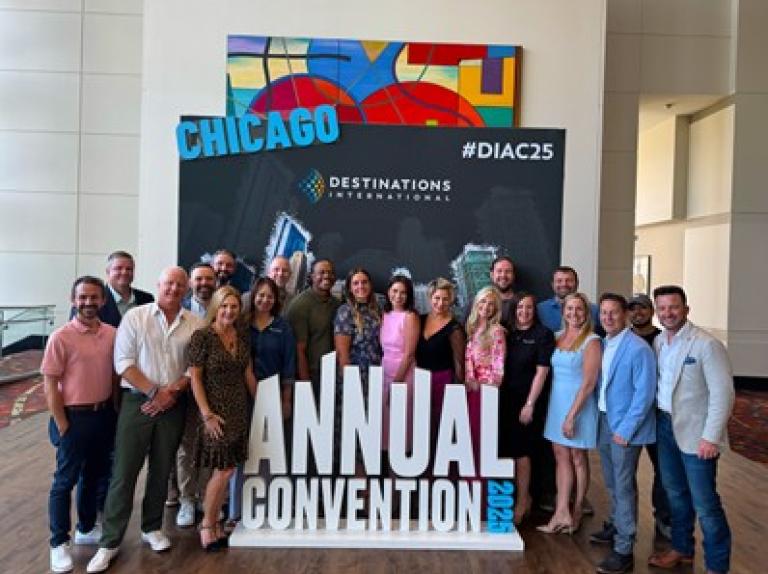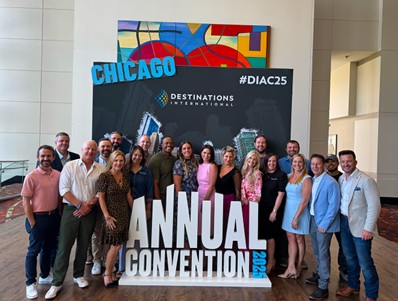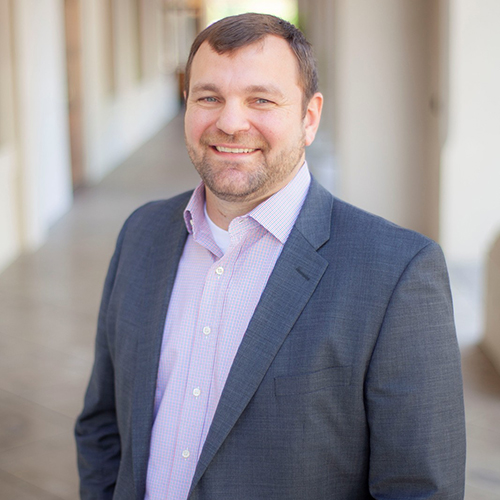
From AI-fueled content to inclusion that builds real belonging, this year’s Destinations International convention made one thing clear: travel marketing is evolving fast—and smart communities are evolving with it. We break down the biggest shifts shaping the industry and how DMOs can turn those changes into opportunity.
Let’s talk AI. 57% of online content is already AI-generated. So if your website still sounds like it’s trying to win a spelling bee, it’s time for a rewrite.
It is becoming very clear that search is no longer predicated on targeting the right keywords but instead its emphasizing human-driven expertise. Google's AI Overviews are crawling content across the web and stitching together answers and guess what? They’re prioritizing sources that sound like experts. Even better? Sources that feel like they were written by humans.
That’s why it’s time for communities to get intentional about their digital identity—because AI isn’t pulling from just your marketing site. It’s pulling from the internet’s collective understanding of your place, meaning Reddit threads, YouTube comments, or Instagram Reels. The more credible, conversational, and human your content is, the more your community shows up in the ways people are actually searching. That means tapping into local voices—yes, even the bartender with the best late-night recs—and shaping content around the real questions travelers are asking. For more on how to effectively optimize content in this AI-driven world, check out our guide on Generative Engine Optimization here.
Your Website Isn’t a Brochure—It’s a Brain
AI is changing the role your website plays in how travelers discover, trust, and choose your community. Google’s AI Overviews are pulling from content that sounds expert, feels human, and answers real questions. That means your site isn’t just a place for pretty pictures and static listings anymore but rather it’s a primary source.
We’re building sites that think. Sites that don’t just display information—they understand intent. Think the Land of Waterfalls experience on Explore Brevard’s website, where immersive storytelling meets strategic trip planning. Think of the hand-illustrated interactive map on The Palm Beaches’ website, turning exploration into an experience before visitors even arrive. And think of Discover Atlanta’s website, where we’ve integrated AI and natural language processing (NLP) into every layer—powering smarter search, intuitive content delivery, and conversations that actually help travelers plan, not scroll.
These aren’t one-off features—they’re purposeful tools layered with story, designed to meet real questions with real answers.
But here’s the unlock: it’s not just tools. It’s stories told by locals, business owners, artists, and experts. These stories get quoted by AI, shared by creators, and remembered by travelers. Why? Because they read like real people wrote them. (Because they did.)
We help communities build content ecosystems that fuel AI discovery, human connection, and search performance all at once. That means optimizing for intent, writing for curiosity, and designing your site to act as both source and storyteller.
Want to see what that looks like in action? Start with Visit Idaho or Discover Puerto Rico. Don’t just chase rankings anymore, own your narrative. And the results will speak human and search fluently.
Inclusion Isn’t a Theme—It’s How You Show Up
In tourism marketing, inclusivity doesn't just check boxes. It shows up in ways that feel real, relevant, and rooted in your community. It means representing the full spectrum of people who live in and visit a place, and creating experiences where everyone feels seen and welcome. That’s more than messaging. It’s mindset, imagery, language, access, and intent.
One of the clearest examples of putting this into action: our work with Eureka Springs. The “Free to Be” campaign didn’t start with a tagline. It started with listening. We talked to locals. We dug into what makes Eureka Springs different. We built trust with LGBTQ+ business owners. We asked: What does it really mean to be free here?
The outcome was a campaign built by the community, for the community. From visual direction to paid media to PR outreach, every element was designed to celebrate belonging—not market to it.
For a deeper look at how inclusivity shows up in marketing language and design, check out our Code Switching webinar.
Sustainability Is a Story Worth Repeating
Sustainable travel is no longer a “trend,” it’s an expectation. According to Booking.com’s 2023 Sustainable Travel Report, more than 80% of global travelers say sustainable tourism is important to them, and nearly 60% say they actively seek out eco-conscious travel options when planning a trip. But caring about the planet isn’t enough. If your sustainability story is buried in a footer link or written in corporate-speak, travelers will scroll past it.
The good news? This is where storytelling can actually shift behavior.
We’ve seen it firsthand—from the “Green Path” with Discover Puerto Rico, to Flynn’s mascot-led environmental messaging in Port Aransas, to Door County’s thoughtful push for responsible visitation. What these communities have in common: they’re not preaching. They’re inviting travelers into something meaningful.
As Dalissa Zeda from Discover Puerto Rico said best during her Flashes of Brilliance Microsession, it’s about “turning good intentions into action.” That action? It looks like this:
- Website experiences that surface eco-conscious choices front and center—not buried in the sitemap
- Campaigns that educate without lecturing—showing the why behind the ask, whether it’s packing reef-safe sunscreen or staying on marked trails
- Content told by locals, conservationists, or park rangers—not anonymous copy blocks
It’s not about slapping a recycling badge on your site or posting a one-off Earth Day message. It’s about making sustainability part of your brand’s DNA—real, ongoing, and human. When the message is clear, the action feels easy. And the impact is the kind of story worth repeating.
Streaming Isn’t the Future. It’s Now.
Let’s get into some more numbers. YouTube alone claims over 12.5% of all streaming watch time—more than Netflix and Amazon combined. If you’re not building content for this channel, you’re missing the moment.
For destinations, this shift demands more than a single video drop. It calls for multi-use, high-return storytelling. AKA, content that works across every platform, every phase of the funnel, and every audience touchpoint. We’re not talking about producing one polished piece but rather creating something so strong, it earns clicks and credibility, boosts SEO, drives paid performance, and gives social teams something to run with for months.
The “3100” Series for Visit Idaho that we collaborated with Fisher Creative on? That’s what we mean by multi-use, high-return storytelling. Long-form video that fills YouTube libraries, powers social, becomes advertising gold, and gets people searching. Don’t look at YouTube as a distribution channel anymore—it’s your second homepage.
PR Isn’t a Megaphone—It’s a Strategy
In today’s media landscape, spray-and-pray press releases don’t cut it. Journalists aren’t looking for filler—they’re looking for stories that matter. And destinations can’t afford to be reactive. A proactive, people-first PR strategy is no longer optional…it's essential. Our crisis communications blog breaks down why that shift matters now more than ever.
Our team goes beyond pitching and building relationships. We connect with journalists not just as gatekeepers, but as collaborators. We understand their timelines, their beats, and their inbox fatigue. And we deliver stories with depth, not fluff.
Our work with Visit Savannah is a perfect example. Instead of sending a templated itinerary, we created a street-level activation tied to a cultural moment—one that gave writers something real to experience and something meaningful to write about and the result was coverage that didn’t read like marketing. It felt like discovery.
Even group FAMs—once considered outdated—have become networking powerhouses when done right. Writers don’t just leave with content, but most importantly, they leave with connections. That’s no accident. It’s a PR approach rooted in trust, humanity, and long-term impact. Less transactional, more transformational.
In a world of shifting headlines and disappearing newsrooms, the destinations showing up with real stories—and real people—are the ones staying top of mind. How are you making sure yours is one of them?

Headed to Portland Next Year? Here’s How to Make It Count
If Destinations International’s Annual Convention is on your radar for 2026 (and it should be), here’s our best advice for squeezing every ounce of value from the experience—whether you’re there for insights, inspiration, or a killer coffee rec (Portland’s got you covered):
1. Don’t just attend sessions—chase the conversation.
The best insights often come after the panel. Stick around, ask the follow-up, talk to the speaker. The hallway takeaways? Gold.
2. Be strategic with your time, not your title.
You don’t need to be the biggest voice in the room to have a meaningful exchange. Whether you're a Marketing Manager or a CEO, the goal is the same: find people who get it and get talking.
3. Bring the business card—but lead with curiosity.
Networking breaks aren’t just for pitching. They’re for connecting. Ask someone about a challenge they’re navigating or the last idea that made them jealous. Be memorable by being real.
4. Use Portland to Sharpen What’s Next.
If your community is wrestling with AI, sustainability, storytelling, or PR strategy—this is where you pressure test ideas, share wins (and misses), and walk away with actionable strategies. At Madden, we’ve always played the long game by betting big on what actually matters—community voice, emotional connection, and storytelling that sticks. The sessions that stick with you? They’re the ones rooted in that same mindset.
5. Follow up. Then follow through.
Whether it's a potential partner, a new idea, or a speaker who dropped a knowledge bomb—send the email, ask the question, continue the momentum.
We’ll be there—coffee in hand, ideas ready to roll. Planning to attend? Let’s connect.
In the meantime, follow along as we partner with 200+ communities across the country this year—stay up to date with us (LinkedIn, Instagram, Facebook) and keep an eye on what’s new with us and the communities we support.
This industry doesn’t run on business cards and booth drops—it runs on people who care deeply about the communities they serve.
See you in Portland.
Submit Your Thought Leadership

Share your thought leadership with the Destinations International team! Learn how to submit a case study, blog or other piece of content to DI.


